Analyzing Unilever's HR, Talent Strategy, and Sustainable Business
VerifiedAdded on 2023/06/11
|8
|2068
|364
Case Study
AI Summary
This case study delves into Unilever's business strategies, focusing on its Sustainable Living Plan (SLP), HR practices, and talent management approaches. It highlights Unilever's commitment to sustainable growth by decoupling environmental impact from business expansion and increasing social impact. The analysis covers key aspects such as improving health and well-being, reducing environmental footprint, and enhancing livelihoods through various pillars like sustainable sourcing and fairness in the workplace. The study also explores Unilever's innovative recruitment processes, including neuroscience-based games and AI-driven assessments, aimed at diversifying talent acquisition and improving cost efficiency. Furthermore, it examines the company's efforts in aligning HR policies with business objectives, fostering employee motivation, and adapting to the changing dynamics of the global market. Unilever's collaborative approach to talent acquisition and its emphasis on leadership development are also discussed, underscoring the importance of a unified vision and strategic execution across its global operations. The case study concludes by considering the compatibility of Unilever's strategies for smaller organizations, emphasizing the need for sustainable strategies, behavioral change campaigns, and adaptability to local needs while maintaining core organizational goals. Desklib provides access to similar case studies and solved assignments for students.
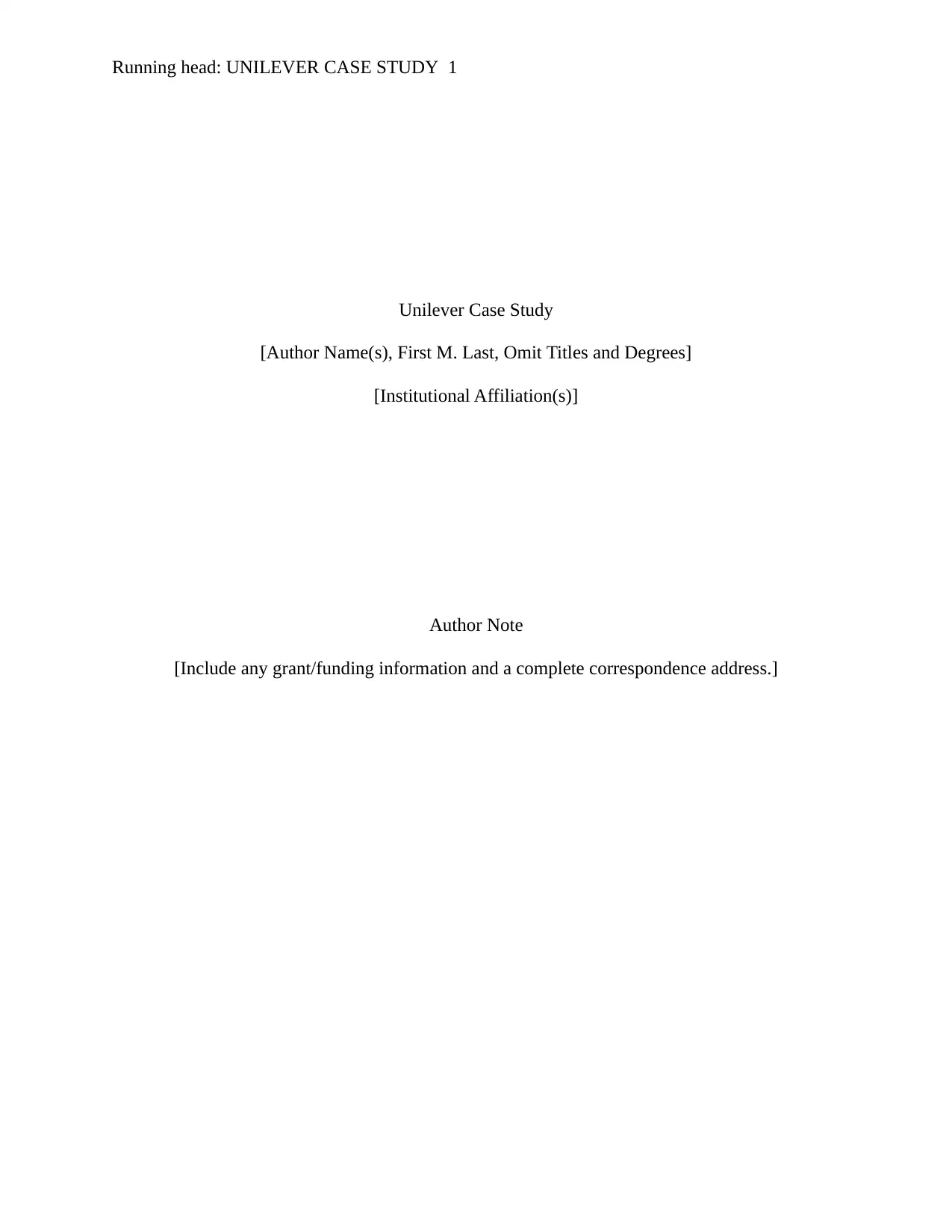
Running head: UNILEVER CASE STUDY 1
Unilever Case Study
[Author Name(s), First M. Last, Omit Titles and Degrees]
[Institutional Affiliation(s)]
Author Note
[Include any grant/funding information and a complete correspondence address.]
Unilever Case Study
[Author Name(s), First M. Last, Omit Titles and Degrees]
[Institutional Affiliation(s)]
Author Note
[Include any grant/funding information and a complete correspondence address.]
Paraphrase This Document
Need a fresh take? Get an instant paraphrase of this document with our AI Paraphraser
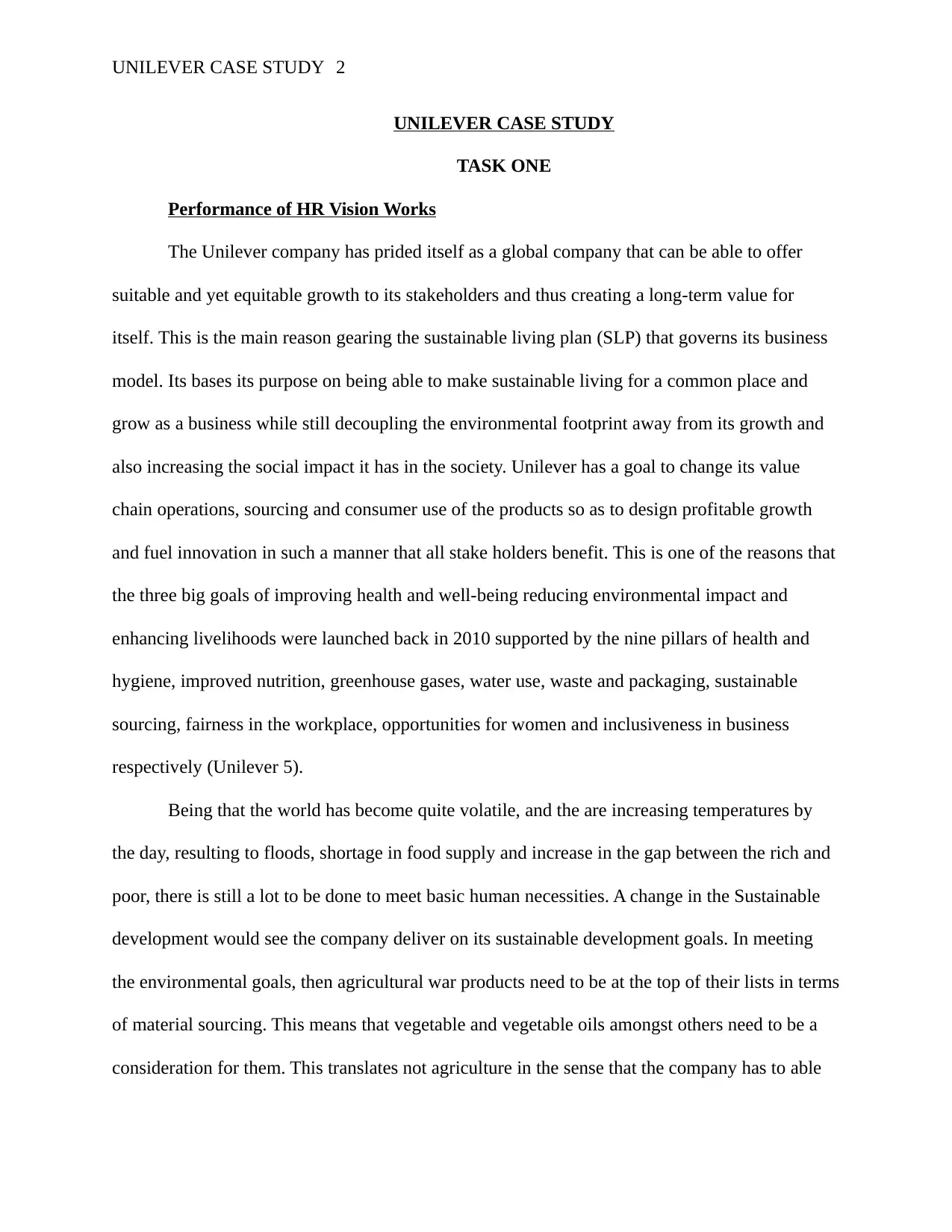
UNILEVER CASE STUDY 2
UNILEVER CASE STUDY
TASK ONE
Performance of HR Vision Works
The Unilever company has prided itself as a global company that can be able to offer
suitable and yet equitable growth to its stakeholders and thus creating a long-term value for
itself. This is the main reason gearing the sustainable living plan (SLP) that governs its business
model. Its bases its purpose on being able to make sustainable living for a common place and
grow as a business while still decoupling the environmental footprint away from its growth and
also increasing the social impact it has in the society. Unilever has a goal to change its value
chain operations, sourcing and consumer use of the products so as to design profitable growth
and fuel innovation in such a manner that all stake holders benefit. This is one of the reasons that
the three big goals of improving health and well-being reducing environmental impact and
enhancing livelihoods were launched back in 2010 supported by the nine pillars of health and
hygiene, improved nutrition, greenhouse gases, water use, waste and packaging, sustainable
sourcing, fairness in the workplace, opportunities for women and inclusiveness in business
respectively (Unilever 5).
Being that the world has become quite volatile, and the are increasing temperatures by
the day, resulting to floods, shortage in food supply and increase in the gap between the rich and
poor, there is still a lot to be done to meet basic human necessities. A change in the Sustainable
development would see the company deliver on its sustainable development goals. In meeting
the environmental goals, then agricultural war products need to be at the top of their lists in terms
of material sourcing. This means that vegetable and vegetable oils amongst others need to be a
consideration for them. This translates not agriculture in the sense that the company has to able
UNILEVER CASE STUDY
TASK ONE
Performance of HR Vision Works
The Unilever company has prided itself as a global company that can be able to offer
suitable and yet equitable growth to its stakeholders and thus creating a long-term value for
itself. This is the main reason gearing the sustainable living plan (SLP) that governs its business
model. Its bases its purpose on being able to make sustainable living for a common place and
grow as a business while still decoupling the environmental footprint away from its growth and
also increasing the social impact it has in the society. Unilever has a goal to change its value
chain operations, sourcing and consumer use of the products so as to design profitable growth
and fuel innovation in such a manner that all stake holders benefit. This is one of the reasons that
the three big goals of improving health and well-being reducing environmental impact and
enhancing livelihoods were launched back in 2010 supported by the nine pillars of health and
hygiene, improved nutrition, greenhouse gases, water use, waste and packaging, sustainable
sourcing, fairness in the workplace, opportunities for women and inclusiveness in business
respectively (Unilever 5).
Being that the world has become quite volatile, and the are increasing temperatures by
the day, resulting to floods, shortage in food supply and increase in the gap between the rich and
poor, there is still a lot to be done to meet basic human necessities. A change in the Sustainable
development would see the company deliver on its sustainable development goals. In meeting
the environmental goals, then agricultural war products need to be at the top of their lists in terms
of material sourcing. This means that vegetable and vegetable oils amongst others need to be a
consideration for them. This translates not agriculture in the sense that the company has to able
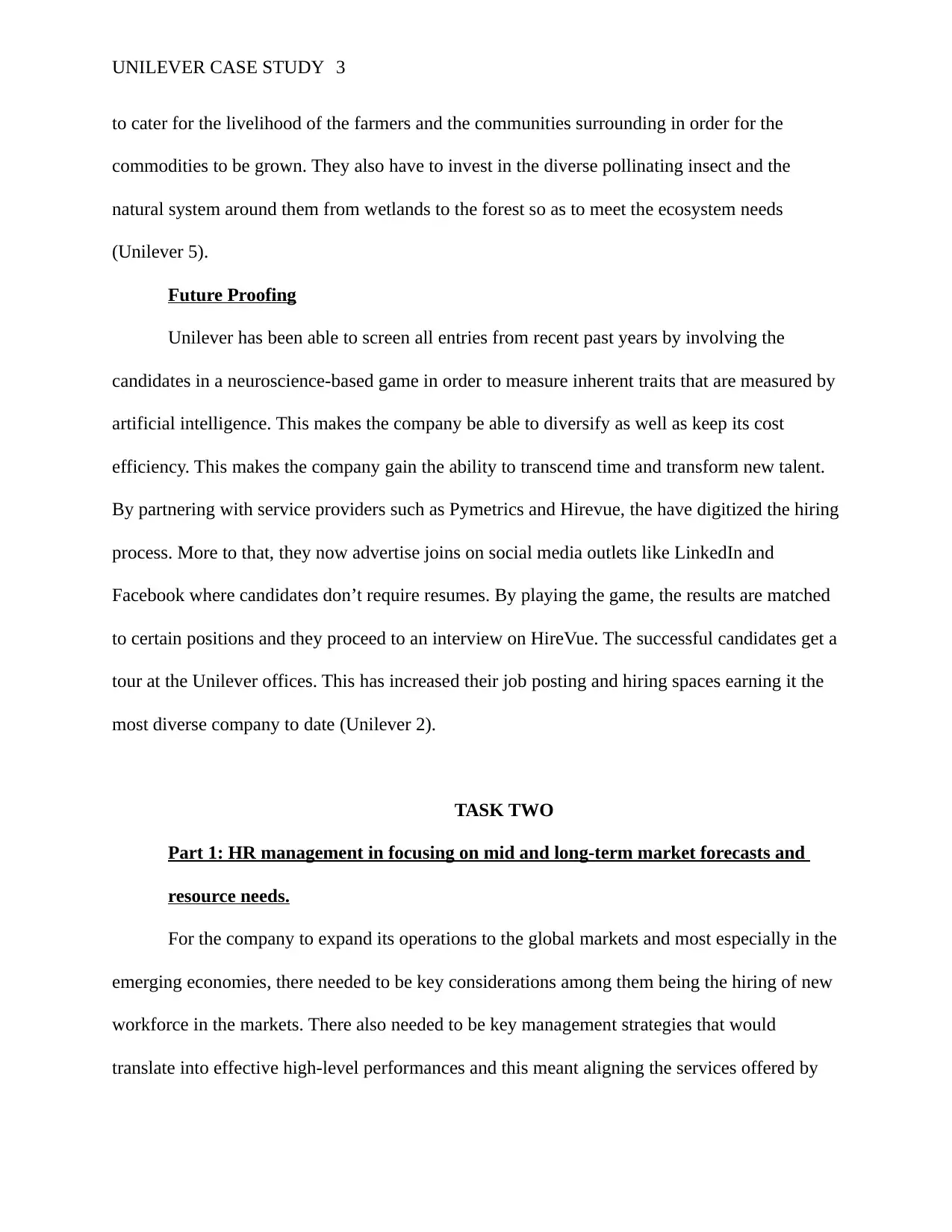
UNILEVER CASE STUDY 3
to cater for the livelihood of the farmers and the communities surrounding in order for the
commodities to be grown. They also have to invest in the diverse pollinating insect and the
natural system around them from wetlands to the forest so as to meet the ecosystem needs
(Unilever 5).
Future Proofing
Unilever has been able to screen all entries from recent past years by involving the
candidates in a neuroscience-based game in order to measure inherent traits that are measured by
artificial intelligence. This makes the company be able to diversify as well as keep its cost
efficiency. This makes the company gain the ability to transcend time and transform new talent.
By partnering with service providers such as Pymetrics and Hirevue, the have digitized the hiring
process. More to that, they now advertise joins on social media outlets like LinkedIn and
Facebook where candidates don’t require resumes. By playing the game, the results are matched
to certain positions and they proceed to an interview on HireVue. The successful candidates get a
tour at the Unilever offices. This has increased their job posting and hiring spaces earning it the
most diverse company to date (Unilever 2).
TASK TWO
Part 1: HR management in focusing on mid and long-term market forecasts and
resource needs.
For the company to expand its operations to the global markets and most especially in the
emerging economies, there needed to be key considerations among them being the hiring of new
workforce in the markets. There also needed to be key management strategies that would
translate into effective high-level performances and this meant aligning the services offered by
to cater for the livelihood of the farmers and the communities surrounding in order for the
commodities to be grown. They also have to invest in the diverse pollinating insect and the
natural system around them from wetlands to the forest so as to meet the ecosystem needs
(Unilever 5).
Future Proofing
Unilever has been able to screen all entries from recent past years by involving the
candidates in a neuroscience-based game in order to measure inherent traits that are measured by
artificial intelligence. This makes the company be able to diversify as well as keep its cost
efficiency. This makes the company gain the ability to transcend time and transform new talent.
By partnering with service providers such as Pymetrics and Hirevue, the have digitized the hiring
process. More to that, they now advertise joins on social media outlets like LinkedIn and
Facebook where candidates don’t require resumes. By playing the game, the results are matched
to certain positions and they proceed to an interview on HireVue. The successful candidates get a
tour at the Unilever offices. This has increased their job posting and hiring spaces earning it the
most diverse company to date (Unilever 2).
TASK TWO
Part 1: HR management in focusing on mid and long-term market forecasts and
resource needs.
For the company to expand its operations to the global markets and most especially in the
emerging economies, there needed to be key considerations among them being the hiring of new
workforce in the markets. There also needed to be key management strategies that would
translate into effective high-level performances and this meant aligning the services offered by
⊘ This is a preview!⊘
Do you want full access?
Subscribe today to unlock all pages.

Trusted by 1+ million students worldwide
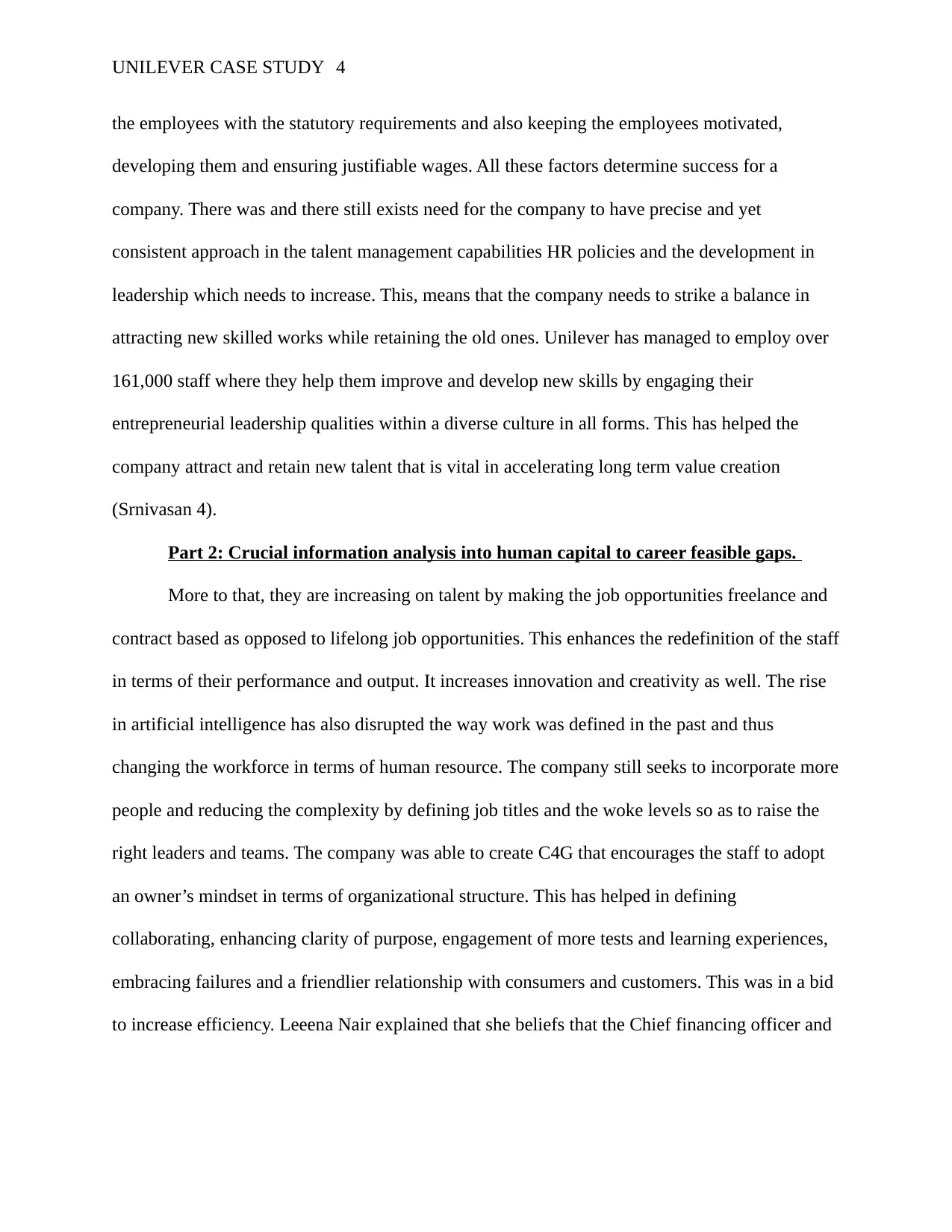
UNILEVER CASE STUDY 4
the employees with the statutory requirements and also keeping the employees motivated,
developing them and ensuring justifiable wages. All these factors determine success for a
company. There was and there still exists need for the company to have precise and yet
consistent approach in the talent management capabilities HR policies and the development in
leadership which needs to increase. This, means that the company needs to strike a balance in
attracting new skilled works while retaining the old ones. Unilever has managed to employ over
161,000 staff where they help them improve and develop new skills by engaging their
entrepreneurial leadership qualities within a diverse culture in all forms. This has helped the
company attract and retain new talent that is vital in accelerating long term value creation
(Srnivasan 4).
Part 2: Crucial information analysis into human capital to career feasible gaps.
More to that, they are increasing on talent by making the job opportunities freelance and
contract based as opposed to lifelong job opportunities. This enhances the redefinition of the staff
in terms of their performance and output. It increases innovation and creativity as well. The rise
in artificial intelligence has also disrupted the way work was defined in the past and thus
changing the workforce in terms of human resource. The company still seeks to incorporate more
people and reducing the complexity by defining job titles and the woke levels so as to raise the
right leaders and teams. The company was able to create C4G that encourages the staff to adopt
an owner’s mindset in terms of organizational structure. This has helped in defining
collaborating, enhancing clarity of purpose, engagement of more tests and learning experiences,
embracing failures and a friendlier relationship with consumers and customers. This was in a bid
to increase efficiency. Leeena Nair explained that she beliefs that the Chief financing officer and
the employees with the statutory requirements and also keeping the employees motivated,
developing them and ensuring justifiable wages. All these factors determine success for a
company. There was and there still exists need for the company to have precise and yet
consistent approach in the talent management capabilities HR policies and the development in
leadership which needs to increase. This, means that the company needs to strike a balance in
attracting new skilled works while retaining the old ones. Unilever has managed to employ over
161,000 staff where they help them improve and develop new skills by engaging their
entrepreneurial leadership qualities within a diverse culture in all forms. This has helped the
company attract and retain new talent that is vital in accelerating long term value creation
(Srnivasan 4).
Part 2: Crucial information analysis into human capital to career feasible gaps.
More to that, they are increasing on talent by making the job opportunities freelance and
contract based as opposed to lifelong job opportunities. This enhances the redefinition of the staff
in terms of their performance and output. It increases innovation and creativity as well. The rise
in artificial intelligence has also disrupted the way work was defined in the past and thus
changing the workforce in terms of human resource. The company still seeks to incorporate more
people and reducing the complexity by defining job titles and the woke levels so as to raise the
right leaders and teams. The company was able to create C4G that encourages the staff to adopt
an owner’s mindset in terms of organizational structure. This has helped in defining
collaborating, enhancing clarity of purpose, engagement of more tests and learning experiences,
embracing failures and a friendlier relationship with consumers and customers. This was in a bid
to increase efficiency. Leeena Nair explained that she beliefs that the Chief financing officer and
Paraphrase This Document
Need a fresh take? Get an instant paraphrase of this document with our AI Paraphraser
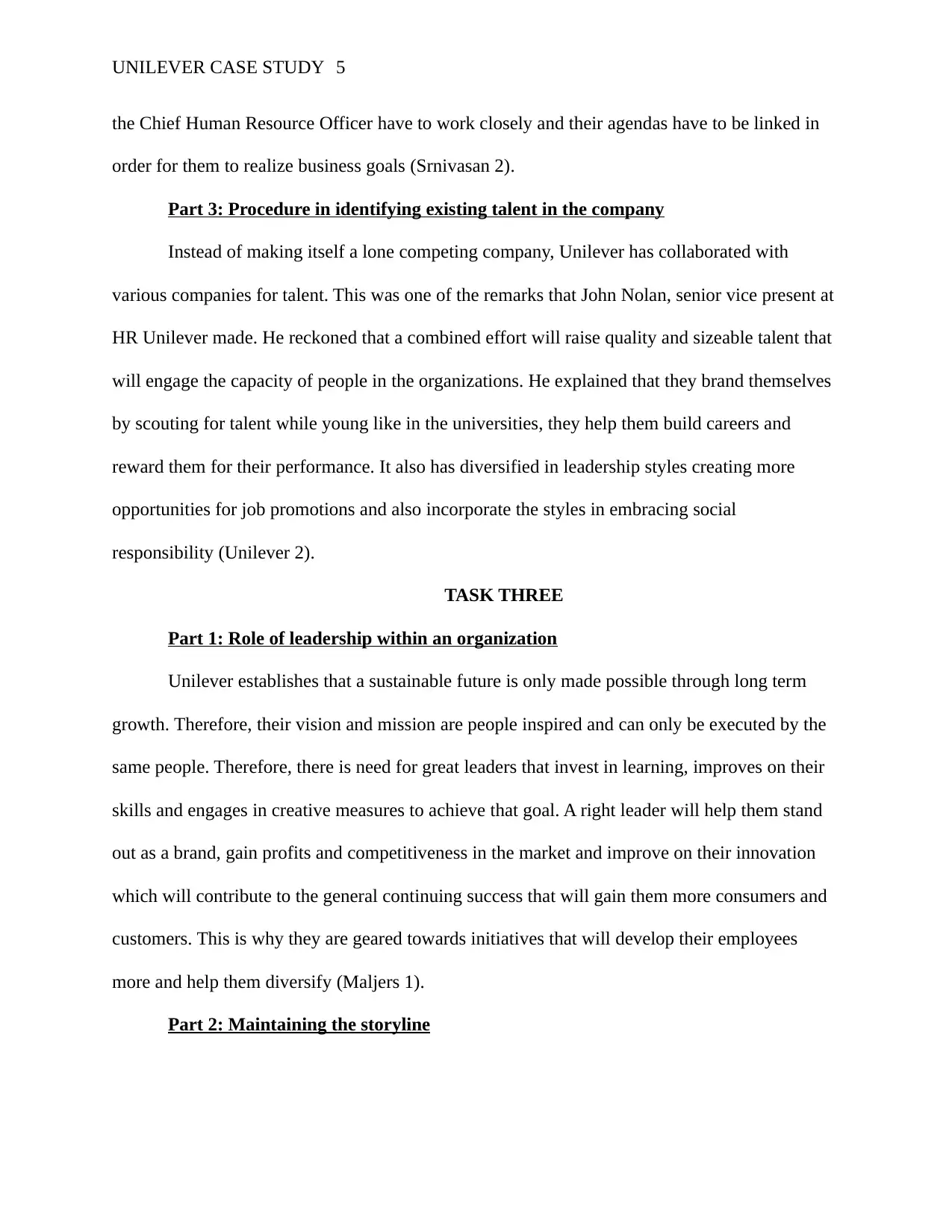
UNILEVER CASE STUDY 5
the Chief Human Resource Officer have to work closely and their agendas have to be linked in
order for them to realize business goals (Srnivasan 2).
Part 3: Procedure in identifying existing talent in the company
Instead of making itself a lone competing company, Unilever has collaborated with
various companies for talent. This was one of the remarks that John Nolan, senior vice present at
HR Unilever made. He reckoned that a combined effort will raise quality and sizeable talent that
will engage the capacity of people in the organizations. He explained that they brand themselves
by scouting for talent while young like in the universities, they help them build careers and
reward them for their performance. It also has diversified in leadership styles creating more
opportunities for job promotions and also incorporate the styles in embracing social
responsibility (Unilever 2).
TASK THREE
Part 1: Role of leadership within an organization
Unilever establishes that a sustainable future is only made possible through long term
growth. Therefore, their vision and mission are people inspired and can only be executed by the
same people. Therefore, there is need for great leaders that invest in learning, improves on their
skills and engages in creative measures to achieve that goal. A right leader will help them stand
out as a brand, gain profits and competitiveness in the market and improve on their innovation
which will contribute to the general continuing success that will gain them more consumers and
customers. This is why they are geared towards initiatives that will develop their employees
more and help them diversify (Maljers 1).
Part 2: Maintaining the storyline
the Chief Human Resource Officer have to work closely and their agendas have to be linked in
order for them to realize business goals (Srnivasan 2).
Part 3: Procedure in identifying existing talent in the company
Instead of making itself a lone competing company, Unilever has collaborated with
various companies for talent. This was one of the remarks that John Nolan, senior vice present at
HR Unilever made. He reckoned that a combined effort will raise quality and sizeable talent that
will engage the capacity of people in the organizations. He explained that they brand themselves
by scouting for talent while young like in the universities, they help them build careers and
reward them for their performance. It also has diversified in leadership styles creating more
opportunities for job promotions and also incorporate the styles in embracing social
responsibility (Unilever 2).
TASK THREE
Part 1: Role of leadership within an organization
Unilever establishes that a sustainable future is only made possible through long term
growth. Therefore, their vision and mission are people inspired and can only be executed by the
same people. Therefore, there is need for great leaders that invest in learning, improves on their
skills and engages in creative measures to achieve that goal. A right leader will help them stand
out as a brand, gain profits and competitiveness in the market and improve on their innovation
which will contribute to the general continuing success that will gain them more consumers and
customers. This is why they are geared towards initiatives that will develop their employees
more and help them diversify (Maljers 1).
Part 2: Maintaining the storyline
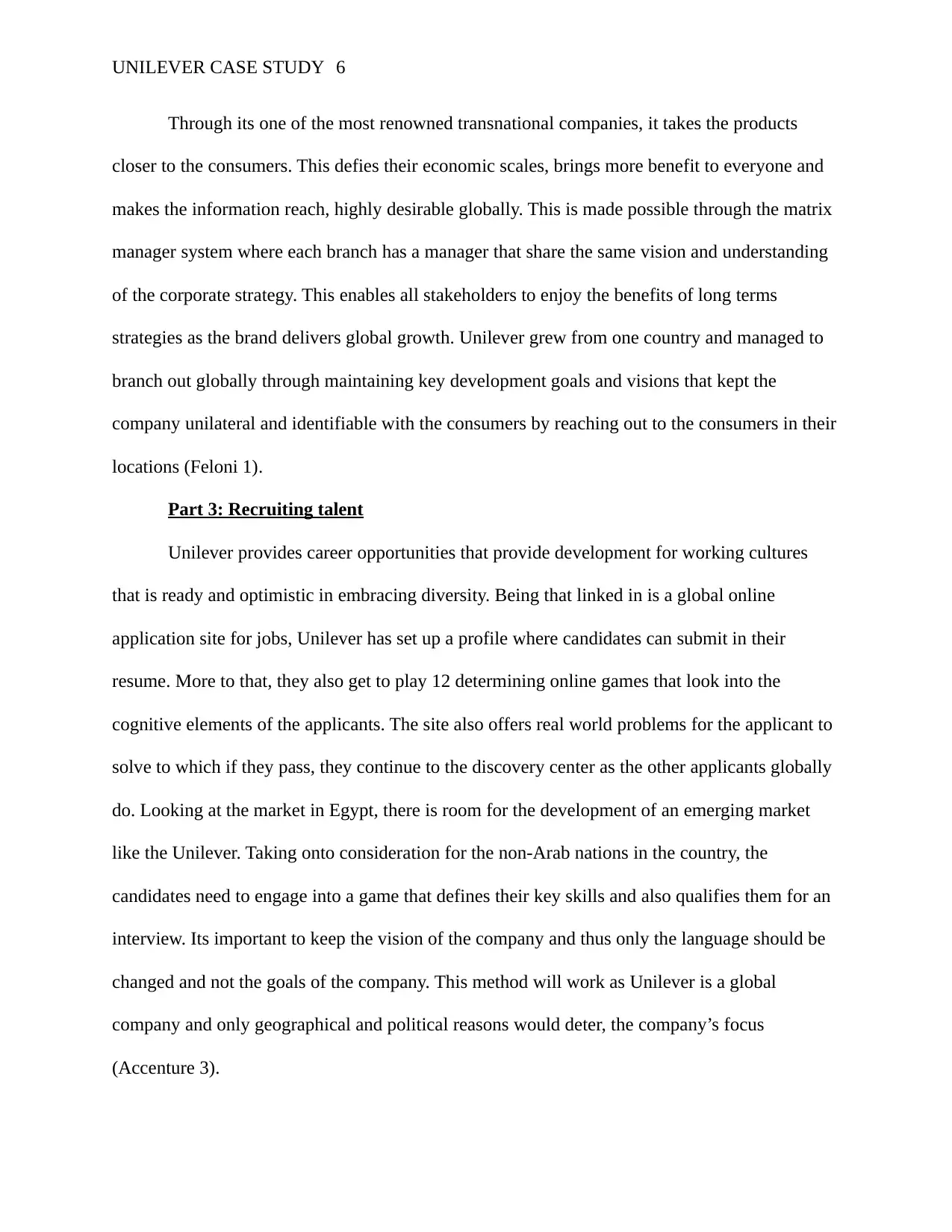
UNILEVER CASE STUDY 6
Through its one of the most renowned transnational companies, it takes the products
closer to the consumers. This defies their economic scales, brings more benefit to everyone and
makes the information reach, highly desirable globally. This is made possible through the matrix
manager system where each branch has a manager that share the same vision and understanding
of the corporate strategy. This enables all stakeholders to enjoy the benefits of long terms
strategies as the brand delivers global growth. Unilever grew from one country and managed to
branch out globally through maintaining key development goals and visions that kept the
company unilateral and identifiable with the consumers by reaching out to the consumers in their
locations (Feloni 1).
Part 3: Recruiting talent
Unilever provides career opportunities that provide development for working cultures
that is ready and optimistic in embracing diversity. Being that linked in is a global online
application site for jobs, Unilever has set up a profile where candidates can submit in their
resume. More to that, they also get to play 12 determining online games that look into the
cognitive elements of the applicants. The site also offers real world problems for the applicant to
solve to which if they pass, they continue to the discovery center as the other applicants globally
do. Looking at the market in Egypt, there is room for the development of an emerging market
like the Unilever. Taking onto consideration for the non-Arab nations in the country, the
candidates need to engage into a game that defines their key skills and also qualifies them for an
interview. Its important to keep the vision of the company and thus only the language should be
changed and not the goals of the company. This method will work as Unilever is a global
company and only geographical and political reasons would deter, the company’s focus
(Accenture 3).
Through its one of the most renowned transnational companies, it takes the products
closer to the consumers. This defies their economic scales, brings more benefit to everyone and
makes the information reach, highly desirable globally. This is made possible through the matrix
manager system where each branch has a manager that share the same vision and understanding
of the corporate strategy. This enables all stakeholders to enjoy the benefits of long terms
strategies as the brand delivers global growth. Unilever grew from one country and managed to
branch out globally through maintaining key development goals and visions that kept the
company unilateral and identifiable with the consumers by reaching out to the consumers in their
locations (Feloni 1).
Part 3: Recruiting talent
Unilever provides career opportunities that provide development for working cultures
that is ready and optimistic in embracing diversity. Being that linked in is a global online
application site for jobs, Unilever has set up a profile where candidates can submit in their
resume. More to that, they also get to play 12 determining online games that look into the
cognitive elements of the applicants. The site also offers real world problems for the applicant to
solve to which if they pass, they continue to the discovery center as the other applicants globally
do. Looking at the market in Egypt, there is room for the development of an emerging market
like the Unilever. Taking onto consideration for the non-Arab nations in the country, the
candidates need to engage into a game that defines their key skills and also qualifies them for an
interview. Its important to keep the vision of the company and thus only the language should be
changed and not the goals of the company. This method will work as Unilever is a global
company and only geographical and political reasons would deter, the company’s focus
(Accenture 3).
⊘ This is a preview!⊘
Do you want full access?
Subscribe today to unlock all pages.

Trusted by 1+ million students worldwide
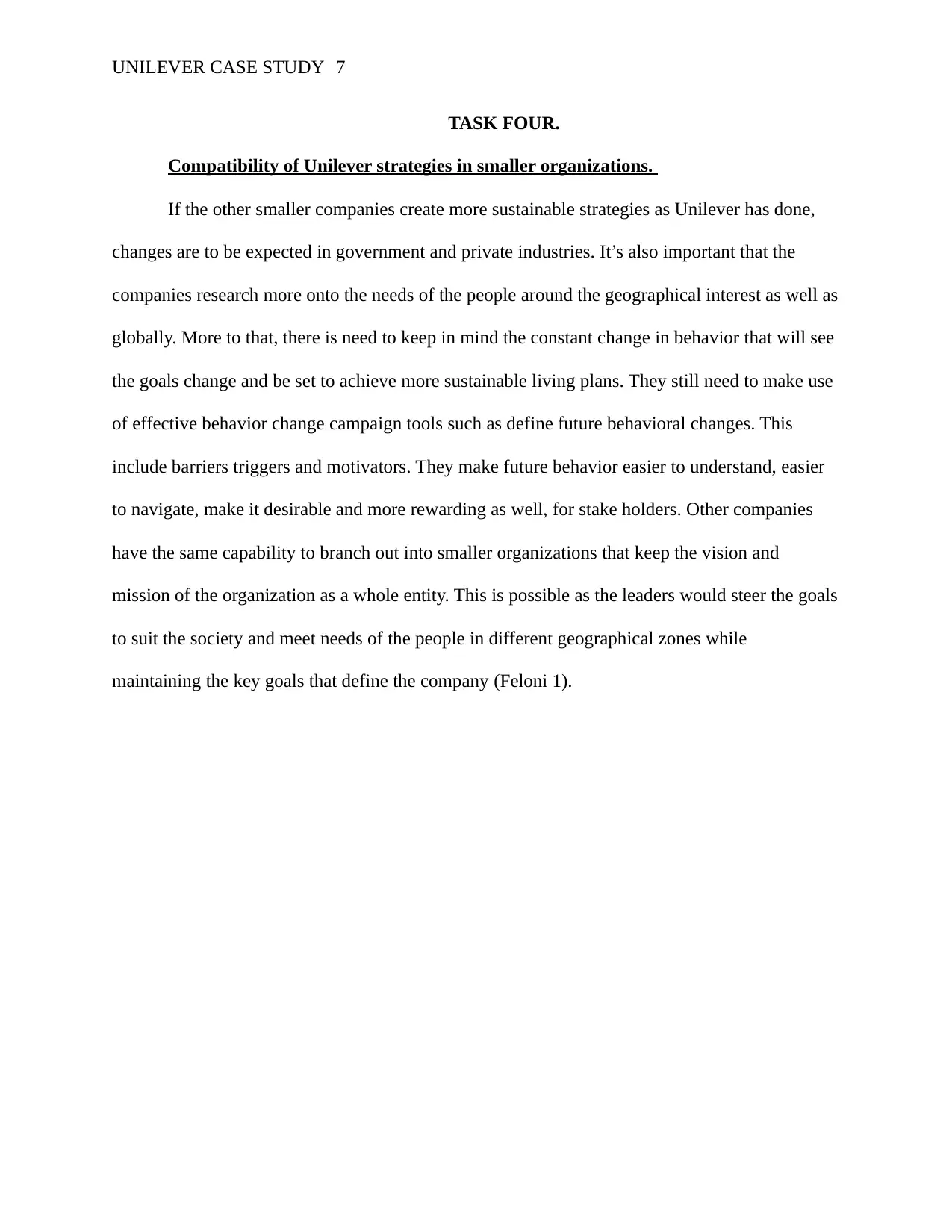
UNILEVER CASE STUDY 7
TASK FOUR.
Compatibility of Unilever strategies in smaller organizations.
If the other smaller companies create more sustainable strategies as Unilever has done,
changes are to be expected in government and private industries. It’s also important that the
companies research more onto the needs of the people around the geographical interest as well as
globally. More to that, there is need to keep in mind the constant change in behavior that will see
the goals change and be set to achieve more sustainable living plans. They still need to make use
of effective behavior change campaign tools such as define future behavioral changes. This
include barriers triggers and motivators. They make future behavior easier to understand, easier
to navigate, make it desirable and more rewarding as well, for stake holders. Other companies
have the same capability to branch out into smaller organizations that keep the vision and
mission of the organization as a whole entity. This is possible as the leaders would steer the goals
to suit the society and meet needs of the people in different geographical zones while
maintaining the key goals that define the company (Feloni 1).
TASK FOUR.
Compatibility of Unilever strategies in smaller organizations.
If the other smaller companies create more sustainable strategies as Unilever has done,
changes are to be expected in government and private industries. It’s also important that the
companies research more onto the needs of the people around the geographical interest as well as
globally. More to that, there is need to keep in mind the constant change in behavior that will see
the goals change and be set to achieve more sustainable living plans. They still need to make use
of effective behavior change campaign tools such as define future behavioral changes. This
include barriers triggers and motivators. They make future behavior easier to understand, easier
to navigate, make it desirable and more rewarding as well, for stake holders. Other companies
have the same capability to branch out into smaller organizations that keep the vision and
mission of the organization as a whole entity. This is possible as the leaders would steer the goals
to suit the society and meet needs of the people in different geographical zones while
maintaining the key goals that define the company (Feloni 1).
Paraphrase This Document
Need a fresh take? Get an instant paraphrase of this document with our AI Paraphraser
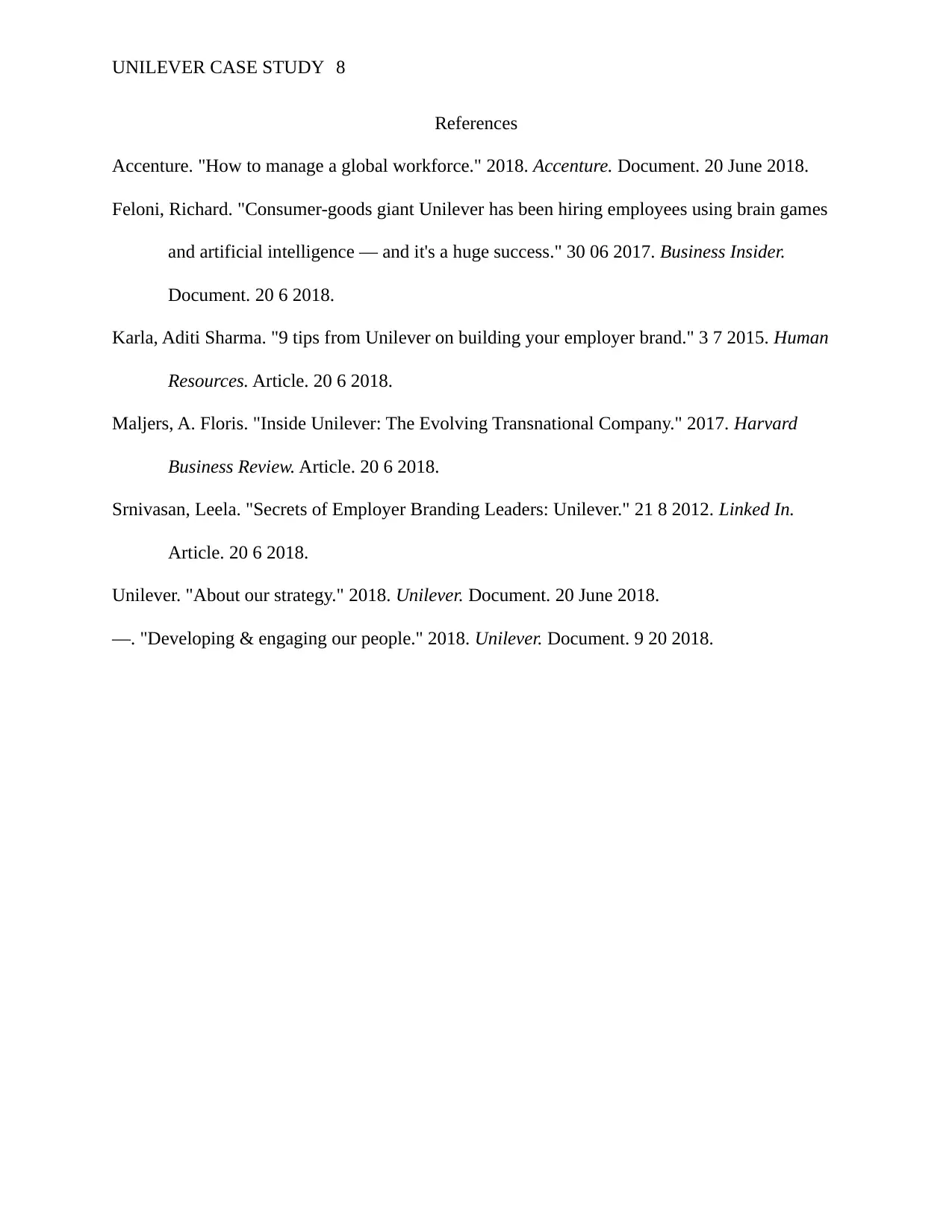
UNILEVER CASE STUDY 8
References
Accenture. "How to manage a global workforce." 2018. Accenture. Document. 20 June 2018.
Feloni, Richard. "Consumer-goods giant Unilever has been hiring employees using brain games
and artificial intelligence — and it's a huge success." 30 06 2017. Business Insider.
Document. 20 6 2018.
Karla, Aditi Sharma. "9 tips from Unilever on building your employer brand." 3 7 2015. Human
Resources. Article. 20 6 2018.
Maljers, A. Floris. "Inside Unilever: The Evolving Transnational Company." 2017. Harvard
Business Review. Article. 20 6 2018.
Srnivasan, Leela. "Secrets of Employer Branding Leaders: Unilever." 21 8 2012. Linked In.
Article. 20 6 2018.
Unilever. "About our strategy." 2018. Unilever. Document. 20 June 2018.
—. "Developing & engaging our people." 2018. Unilever. Document. 9 20 2018.
References
Accenture. "How to manage a global workforce." 2018. Accenture. Document. 20 June 2018.
Feloni, Richard. "Consumer-goods giant Unilever has been hiring employees using brain games
and artificial intelligence — and it's a huge success." 30 06 2017. Business Insider.
Document. 20 6 2018.
Karla, Aditi Sharma. "9 tips from Unilever on building your employer brand." 3 7 2015. Human
Resources. Article. 20 6 2018.
Maljers, A. Floris. "Inside Unilever: The Evolving Transnational Company." 2017. Harvard
Business Review. Article. 20 6 2018.
Srnivasan, Leela. "Secrets of Employer Branding Leaders: Unilever." 21 8 2012. Linked In.
Article. 20 6 2018.
Unilever. "About our strategy." 2018. Unilever. Document. 20 June 2018.
—. "Developing & engaging our people." 2018. Unilever. Document. 9 20 2018.
1 out of 8
Related Documents
Your All-in-One AI-Powered Toolkit for Academic Success.
+13062052269
info@desklib.com
Available 24*7 on WhatsApp / Email
![[object Object]](/_next/static/media/star-bottom.7253800d.svg)
Unlock your academic potential
Copyright © 2020–2025 A2Z Services. All Rights Reserved. Developed and managed by ZUCOL.





